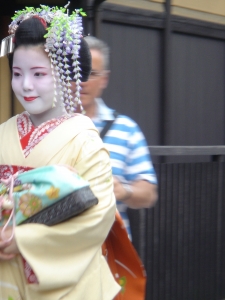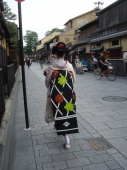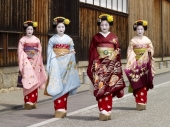Home > Ways to Enjoy in KyotoList > Geisha District
Home > Ways to Enjoy in KyotoList > Geisha District
Area:Higashiyama Ward Way to enjoy: Eating around town Walk around area Cultural Experience

Some begin their daily training at a very early age, whilst others choose to enter the profession later in life. Either way, you train for life, unless you leave your Okiya – the place where you live, train and are indebted to under contract.
Hired to attend parties and private gatherings at ochaya (teahouses) and ryōtei (traditional Japanese restaurants), no one knows where a Geisha will be called to work and the exclusivity of their company means they are not a common sight. Not only do you have to pay the equivalent of hundreds or even thousands of dollars but, in many cases, you must be invited by another person. Therefore, to behold one within the old streets of the ‘Geisha District’ of Gion in Kyoto, as they make their way to work, is a very special sight indeed.
What is the Best Time to see Geisha?
Geisha and Maiko can start work from as early as 8pm, although the general consensus was that anywhere from 10pm – 11pm would give you a higher chance of an appearance.
Where is the Best Area of Gion?
Gion is now a mish-mash of old narrow alleyways and a modern shopping district with a whole host of department stores. Two areas remain the main hubs where the Geisha are called to work – the narrow and mysterious lantern lit street of Pontocho-dori to the west of the river and Hanamikoll-dori on the opposite side, near to the beautifully preserved Shimbashi Street. The main sightings are of them getting out of a taxi or walking the short way directly to the teahouse.
Difference Between a Giesha and a Maiko?
Geisha normally have more subdued and less elaborate clothing, hair and makeup, whereas Maiko are more colourful and bold – the robe is usually patterned, hangs low at the nape of the neck and the obi (the waist tie decoration) is normally more embellished and long, sometimes hanging as low as the ankles.
- Recommended Movie -
"The Memoir of Geisha" http://en.wikipedia.org/wiki/Memoirs_of_a_Geisha_(film)

Today there are five hanamachi in Kyoto:
Hanamachi - (花街 hanamachi?) is a Japanese courtesan and geisha district. The word's literal meaning is "flower street". Such districts would contain various okiya (geisha houses). Nowadays, the term hanamachi is commonly used in modern Japan to refer to the areas where modern-day okiya are still operating. In Kyoto's Gion district, however, the older term kagai is still in use. Alternatively, kagai can be used to refer to licensed red-light districts, which contained restaurants, okiya, and ochaya ("tea houses" where geisha would entertain customers).
Hanamachi typically contained a number of okiya and ochaya, along with a kaburenjō; the kaburenjō was a meeting place for geisha, usually with a theatre, rooms where geisha classes can be held, and the kenban offices, which dealt with geisha's pay, regulation and similar matters. Gion also has a vocational school, called Nyokoba. Many of the teachers there are designated as Living National Treasures.
They are called "Gokagai" generically.
Gion Kobu
Gion Kobu is located close from Yasaka Shrine (also known as Gion-san). The street still has old tea house buildings and has the Edo period atmosphere. They follow Inoue School. The special performance is held in spring (Miyako Odori) and autumn (Onshu-kai).
Gion-Kobu is a ‘monzen-machi’ crowded with visitors and worshippers for Yasaka-jinja Shrine.
It is the largest among five flower towns.
This beautiful town was used as subject matters for novels, set for kabuki many times, and because of that, many people think of it when they hear something about ‘hanamachi.’ I would say that it has the highest popularity not only in Kyoto, but also within Japan. The town has also become well known for Ichiriki-jyaya (one of the most prestigious ochayas) which was used as a location for TV drama, ‘Genroku-ryoran’in Japan.
※Monzen-machi is a town which was formed around powerful shrines and temples.
Gion Kobu Kabukai
570-2 Gion-cho Minami-gawa, Higashiyama-ku, Kyoto
Tel: 075-541-3391
http://www.miyako-odori.jp

Gion Hihashi was started in the Edo period in front of Yasaka Shrine. Gion Kobu and Gion Higashi were one hanamachi until 1881. They follow Fujima School. The special performance is held in autumn (Gion Odori).
The origin of Gionhigashi is related with a site formally was the premises owned by Zezehan, (Zeze Domain) a feudal domain existed around Otsu in Omi Province. Some ochayas were built there and just as well as Gion-Kobu, the town has been prospered with many ‘monzen-chaya.’
Although it is a town with least number of maiko among five flower towns today, there is the Gion-kaikan Theater where maiko and geiko of this town show their splendid performances.
It is the rare classic place where you could enjoy the Showa amusement which hardly exists today. In the Showa period, it was originally used as a movie theater where you could enter or exit freely, enjoy two films a day for a ticket and are allowed to bring in all sorts of food and drinks.
Gion Higashi Kabukai
319 Gion-cho Kitagawa, Higashiyama-ku, Kyoto
Tel: 075-561-0224
Miyagawacho is located on the east side of Kamo River, between Shijo and Gojo. In the Edo period, the area was flourished as a center of theatre play (started by Okuni from Izumo province) and tea house. They follow Wakayagi School. The special performance is held in spring (Kyo Odori).
It is said that Miyagawa-cho has been prospered with a strong link with plays. There was a time when various theaters started to be clustered in this area.
They include a famous kabuki theater, Izumo no Okuni. Because of that, number of accommodations for customers and actors naturally increased little by little. This is said to be origin of Miyagawa-cho as a flower town.
Miyagawacho Kabukai
4-306 Miyagawa-suji, Higashiyama-ku, Kyoto
Tel: 075-561-1154
http://www.eonet.ne.jp/~miyagawacho/
Pontocho is located on the narrow street between Sanjo and Shijo. It is said that a origin of
its name comes from Portuguese word ‘ponto’ meaning the edge.
It started to develop after they constructed new bank on Kamo River. They say the town has been prospered naturally from inns and chaya (same the meaning as ochaya) for the people who shipped on Takase-bune(ship) passed by Takase-gawa River.
The area has its unique atmosphere. They follow Onoe School. The special performance is held in spring (Kamogawa Odori) and autumn (Suimei-kai).
Pontocho Kabukai
Sanjo Ohashi Nishi-zume, Nakagyo-ku, Kyoto
Tel: 075-221-2025
http://www1.odn.ne.jp/~adw58490/
The area started to develop in the Muromachi period when they had a big renovation of Kitano Tenmangu Shrine. The symbol represents the sweet dumpling which was offered to Toyotomi Hideyoshi when he had a big tea party here. They follow Hanayagi School. The special performance is held in spring (Kitano Odori) and autumn (Kotobuki-kai).
In the Muromachi period, when Kitano temnan-gu Shrine suffered from a fire, people took over surplus timber used in the restoration work of it, used them to build seven ochayas.
This was the beginning as a flower town and it was called ‘Shichigen-chaya’ (literally means seven ochayas) in those days. It is located in an area at some little distance from the others, is known as the oldest among five towns in Kyoto.
※Today, ochaya means a place where ozashi is held. In olden days, it used to be a tea-house where teas were served. There were many of them in precincts of shrines and temples, or roadsides. It is said that pilgrims and travelers visiting Kyoto were familiar with them.
Kamishichiken Kabukai
742 Shinsei-cho, Imadegawa-dori Shichihonmatsu-nishi-iru, Kamigyo-ku, Kyoto
Tel: 075-461-0148
http://www.maiko3.com/
Near